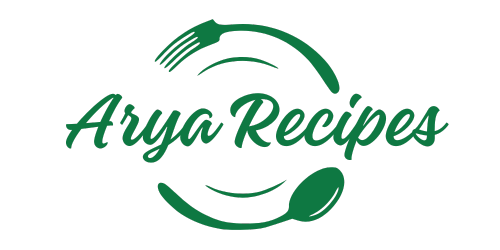Introduction
Oh wow—Spaghetti Carbonara! If there’s one dish that screams Italian comfort food, it’s this beauty. Simple ingredients? Check. Lightning-fast prep? Absolutely. A sauce so creamy and luscious it makes you question the need for actual cream? You bet!
But here’s the thing—Carbonara has been butchered over the years (looking at you, folks adding heavy cream and garlic!). So, let’s set the record straight and bring this dish back to its authentic, glorious roots. We’re talking silky egg-based sauce, crispy guanciale, and that perfect hit of black pepper.
By the time you finish reading, you’ll not only know how to make a flawless Spaghetti Carbonara, but you’ll also understand why it works. And trust me, once you master this recipe, there’s no going back.
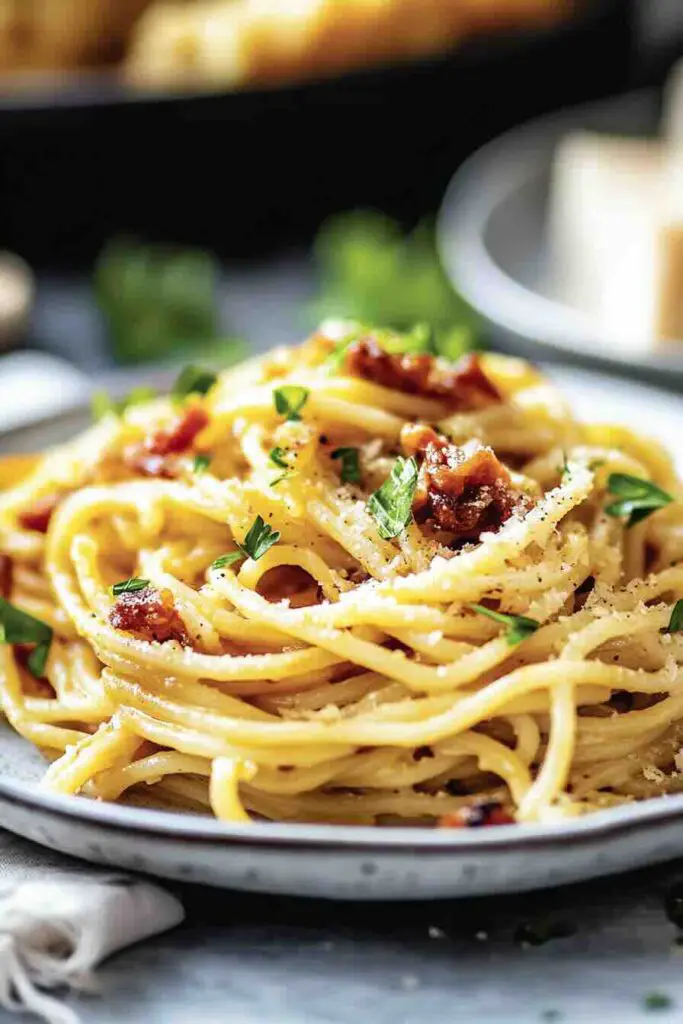
Reasons You’ll Love This Recipe
If you haven’t fallen in love with Carbonara yet, let me convince you:
- Authentic & Traditional – No shortcuts, no unnecessary add-ins, just the classic Roman way.
- Quick & Easy – Dinner in 15 minutes? Yes, please.
- Ultra-Creamy Without Cream – The magical emulsion of eggs, cheese, and pasta water makes this rich without being heavy.
- Budget-Friendly & Minimal Ingredients – Five simple ingredients, most of which you probably already have.
- Tastes Like a Fancy Restaurant Dish – Yet it’s stupidly easy to make at home.
Seriously, once you try it, you’ll never go back to that gloopy, cream-laden version again.
What Makes a Good Spaghetti Carbonara?
The Key to a Perfect Carbonara
A great Carbonara comes down to balance. Get these right, and you’re golden:
- Eggs + Cheese – The heart of the sauce, creating that luxurious texture.
- Guanciale – Salty, fatty, crispy goodness that flavors everything.
- Pasta Water – The secret to emulsifying the sauce.
- Black Pepper – Gives Carbonara its signature bite.
Common Mistakes & How to Avoid Them
- Adding Cream – Just… don’t. You don’t need it.
- Overcooking the Eggs – Scrambled egg pasta? No, thanks. Stir off the heat!
- Using Pre-Grated Cheese – Always go for freshly grated—it melts better.
- Skipping Pasta Water – This is your secret ingredient. Don’t drain it all away!
The Cultural Significance of Carbonara
Carbonara isn’t just pasta—it’s a staple of Roman cuisine. It’s all about simplicity meets perfection, and Italians take it very seriously.
There’s even a debate about what makes it authentic—some say guanciale is a must, while others whisper that pancetta works too. (Bacon? Nope. Just no.)
The History of Spaghetti Carbonara
Origins & Evolution
Carbonara’s origins are a bit of a mystery, but here are some theories:
- Post-WWII – American soldiers brought eggs and bacon rations, inspiring Italian chefs.
- Old-School Italian Pasta – Some say it evolved from pasta cacio e uova, a traditional egg-and-cheese dish.
- 1950s Restaurant Boom – The first written recipe appeared in the 1950s, and boom—it became a legend.
Over the years, people have messed with it (hello, cream and peas?!), but the original remains unbeaten.
Ingredients for Spaghetti Carbonara
The Core Ingredients
- Guanciale – This cured pork cheek is the real deal—crispy, fatty, and packed with flavor. If you must, pancetta works. But bacon? That’s a crime in Italy.
- Eggs – The backbone of the sauce. Use room temperature eggs for best results.
- Pecorino Romano & Parmigiano Reggiano – Sharp, salty, and nutty. Freshly grated, always.
- Spaghetti – Classic, but you can swap in rigatoni or bucatini if you’re feeling rebellious.
- Black Pepper – Go for freshly cracked. Pre-ground pepper is a sad excuse.
Optional Additions & Substitutes
- Garlic – Not traditional, but hey, live your best life.
- Parsley – Adds a pop of freshness.
Step-by-Step Instructions for Authentic Spaghetti Carbonara
1. Prepping the Ingredients
- Slice guanciale into small batons.
- Whisk eggs, grated cheese, and black pepper in a bowl.
2. Cooking the Pasta
- Boil in heavily salted water until just al dente.
- Save some pasta water! This stuff is liquid gold.
3. Cooking the Guanciale
- Fry in a pan until crispy and golden. No oil needed—the fat renders beautifully.
4. The Magic Moment: Bringing It All Together
- Toss cooked pasta into the pan with guanciale fat.
- Turn off the heat. Now mix in the egg mixture, stirring quickly to create that silky, dreamy sauce. Add pasta water as needed to get the perfect texture.
And BOOM. You’ve got restaurant-quality Carbonara at home.
How to Tell When Spaghetti Carbonara is Done
Making Spaghetti Carbonara is all about achieving that perfect texture—a silky, creamy sauce that clings to every strand of pasta without turning into scrambled eggs or a watery mess. But how do you know when it’s done? Well, let’s break it down step by step!
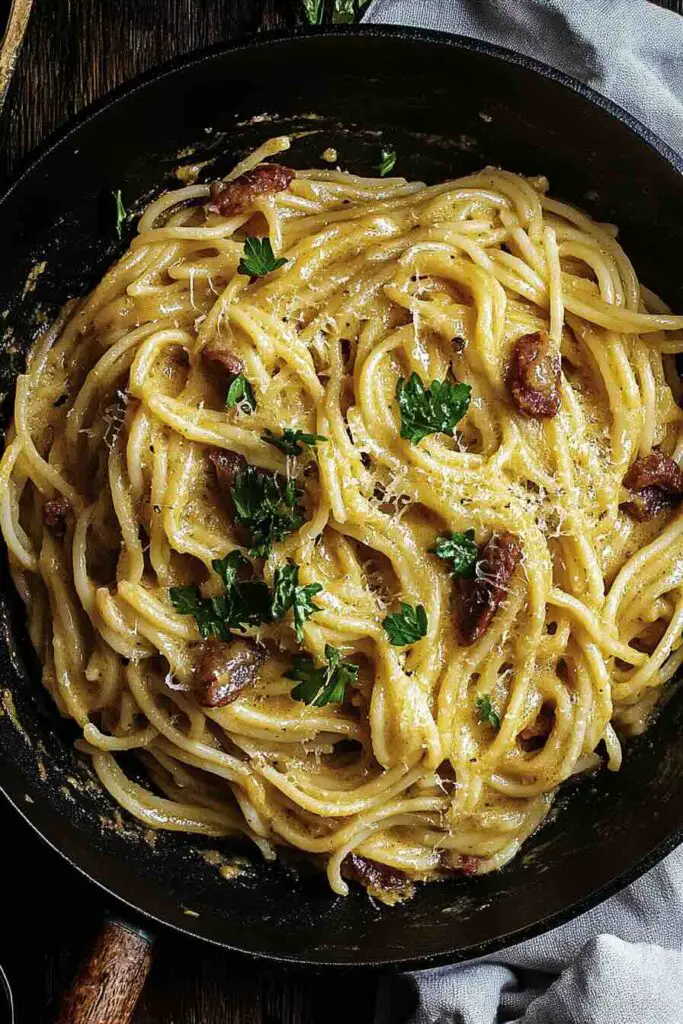
The Sauce Should Be Smooth and Glossy
One of the hallmarks of a perfectly cooked Carbonara is its luxurious, smooth texture. The sauce should be creamy and thick enough to coat the pasta without being lumpy or grainy. If it looks too runny, you might need to mix it a little longer to allow the eggs and cheese to emulsify properly.
However, if your sauce is clumpy or grainy, that’s a sign the eggs have overcooked—meaning the heat was too high or you didn’t mix fast enough. To avoid this, always remove the pan from direct heat before adding the egg mixture and stir vigorously to achieve that signature silkiness.
The Pasta Should Be Coated Evenly
A well-made Carbonara won’t have pools of sauce at the bottom of the bowl or dry spots where the pasta is barely coated. Instead, every single strand of spaghetti should be glossy and well-dressed in the sauce. If some areas look dry while others are overloaded with sauce, keep tossing everything together, adding a splash of pasta water as needed to help with consistency.
There Should Be No Visible Raw Egg or Scrambled Texture
A properly emulsified Carbonara sauce doesn’t have visible streaks of raw egg. If you notice tiny streaks of egg whites or an uneven color, it means the eggs weren’t fully incorporated into the cheese before being added to the pasta. Next time, whisk the eggs and cheese thoroughly before mixing.
On the flip side, if you see clumps of cooked egg, you may have accidentally scrambled them by exposing them to too much heat. In that case, stir off the heat next time and mix quickly to distribute the residual warmth of the pasta evenly.
The Flavor Should Be Balanced
Even if the texture is perfect, the taste matters just as much. A great Carbonara should have a deep, savory umami flavor from the cheese, the richness of the eggs, the saltiness of the guanciale, and the subtle spiciness of freshly cracked black pepper. If it tastes flat, try adding a bit more cheese or an extra sprinkle of black pepper to bring out the flavors.
Variations & Toppings
Exploring Different Carbonara Variations
While purists will argue that Carbonara should never be altered, the truth is that food evolves, and creative variations can offer new and exciting flavors while still maintaining the heart of the dish. Here are some popular takes on Carbonara that have gained popularity over the years.
1. The Classic Roman-Style Carbonara
This is the traditional, no-nonsense version. It’s made with guanciale, eggs, Pecorino Romano, black pepper, and pasta water. No cream, no garlic, no onions—just simple, high-quality ingredients coming together in perfect harmony. If you want to experience Carbonara the way Italians do, this is the version to stick with.
2. Modern Carbonara with Pancetta or Bacon
Although guanciale is the traditional choice, pancetta (cured pork belly) is sometimes used as a substitute. It has a milder flavor and a slightly different fat content, but it still delivers a delicious result. Bacon, while not traditional, is often used in non-Italian versions of Carbonara. It adds a smokier taste, which some people enjoy, but purists will argue that it changes the essence of the dish.
3. Vegetarian Carbonara (Mushroom Carbonara)
For those who don’t eat pork, mushrooms make an excellent replacement for guanciale. Cremini or shiitake mushrooms provide a rich, umami-packed flavor that mimics the depth of cured meat. Some variations also add toasted nuts for texture or use smoked paprika to replicate the smoky depth of guanciale.
4. Seafood Carbonara
A luxurious take on the classic, seafood Carbonara replaces guanciale with shrimp, scallops, or even smoked salmon. The seafood pairs beautifully with the creamy, cheesy sauce, making it an elegant option for a fancy dinner.
5. Truffle Carbonara
If you want to take Carbonara to the next level, a drizzle of truffle oil or a sprinkle of shaved black truffles adds an earthy richness that makes the dish feel like a Michelin-star meal. Just be careful not to overdo it—truffle can be overpowering if used in excess.
Nutritional Insights: Is Spaghetti Carbonara Healthy?
Understanding Spaghetti Carbonara’s Nutritional Profile
Carbonara is rich, satisfying, and packed with flavor, but is it actually healthy? Well, that depends on how you define “healthy.” While it’s not exactly a low-calorie dish, it does contain some key nutrients.
- Protein: The eggs, cheese, and guanciale provide a solid amount of protein, which is essential for muscle growth and repair.
- Healthy Fats: Guanciale contains monounsaturated fats, which are healthier than trans fats found in processed foods.
- Calcium & Vitamins: Pecorino Romano is a good source of calcium, and eggs provide essential B vitamins.
Ways to Make Spaghetti Carbonara Healthier
If you want to enjoy Carbonara without overindulging, here are a few tweaks:
- Use Whole-Wheat Pasta: Adds fiber and makes the dish more filling.
- Reduce the Cheese & Guanciale: Cut back slightly on the cheese and pork to lower the fat content.
- Add Veggies: Toss in some sautéed spinach or zucchini for extra nutrients.
Pro Tips & Tricks for the Best Carbonara
Avoiding Common Mistakes
- Don’t Cook the Eggs Over Direct Heat – The residual heat from the pasta is enough to cook the sauce. Direct heat will turn it into scrambled eggs.
- Use Freshly Grated Cheese – Pre-grated cheese contains anti-caking agents that affect the sauce’s texture.
- Stir Fast, Stir Well – The key to emulsifying the sauce is continuous stirring as soon as the egg mixture hits the pasta.
Maximizing Flavor
- Use high-quality eggs and cheese—they make a huge difference.
- Freshly cracked black pepper adds a bold, spicy depth.
Storage & Reheating Tips
How to Store Spaghetti Carbonara Properly
If you have leftovers, store them in an airtight container in the fridge for up to three days. The key to preserving the sauce is to keep as much moisture as possible.
Best Reheating Methods
- Stovetop: The best way is to reheat it gently in a pan over low heat with a splash of water to loosen the sauce.
- Avoid the Microwave: It will dry out the pasta and scramble the eggs.
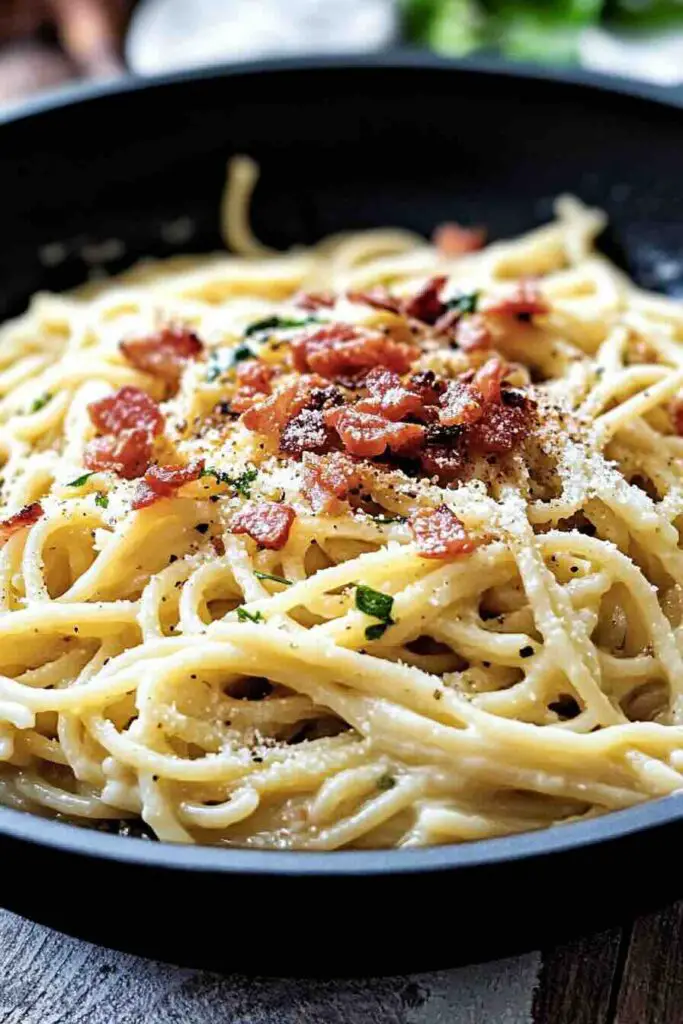
FAQs: Everything You Need to Know About Spaghetti Carbonara
1. What are the essential ingredients in Carbonara?
The classic version includes guanciale, eggs, Pecorino Romano, black pepper, and spaghetti—that’s it!
2. Can I use Parmesan instead of Pecorino Romano?
Yes, but Pecorino is saltier and has a sharper flavor, which gives Carbonara its signature taste.
3. Why did my Carbonara sauce turn into scrambled eggs?
This happens when the eggs are exposed to too much heat. Always mix off the heat and stir quickly to avoid curdling.
4. Can I make Carbonara without pork?
Absolutely! Try using mushrooms or smoked salmon for a vegetarian or seafood twist.
Before You Go…
Craving more goodness? Check out my recipe for Chicken Parmigiana or Spaghetti Bolognese next! It’s just as comforting, indulgent, and easy to make. You’re going to love it! ❤️
Don’t forget to subscribe for more mouthwatering recipes straight to your inbox!
Print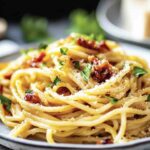
Spaghetti Carbonara
- Prep Time: 5 minutes
- Cook Time: 10 minutes
- Total Time: 15 minutes
- Yield: 4 1x
Description
This authentic Spaghetti Carbonara recipe brings the flavors of Rome straight to your kitchen! Made with simple, high-quality ingredients—guanciale, eggs, Pecorino Romano, black pepper, and pasta water—this dish is rich, creamy (without cream!), and incredibly satisfying. Ready in just 15 minutes, it’s the ultimate comfort food that feels gourmet but is effortless to make. Follow this foolproof method to achieve restaurant-quality Carbonara at home, without the scrambled eggs!
Ingredients
- 12 oz (340g) spaghetti
- 4 oz (115g) guanciale, cut into small batons
- 2 large eggs
- 2 large egg yolks
- 1 cup (100g) Pecorino Romano cheese, finely grated
- 1 tsp freshly ground black pepper, plus more for garnish
- Salt, to taste
- ½ cup reserved pasta water
Instructions
- Boil the Pasta
- Bring a large pot of salted water to a boil.
- Add the spaghetti and cook until al dente (about 1-2 minutes less than package instructions).
- Before draining, reserve ½ cup of pasta water—this is key for the sauce!
- Cook the Guanciale
- While the pasta is cooking, heat a large skillet over medium heat.
- Add the guanciale and cook until crispy and the fat has rendered (about 4-5 minutes).
- Turn off the heat and let it rest.
- Prepare the Egg Mixture
- In a mixing bowl, whisk together the eggs, egg yolks, Pecorino Romano, and black pepper until smooth.
- Combine Everything
- Add the drained pasta directly into the skillet with the guanciale. Toss to coat in the fat.
- Remove the pan from the heat. Quickly pour the egg mixture over the pasta, stirring vigorously to emulsify the sauce. Add small splashes of reserved pasta water to achieve a silky texture.
- Serve Immediately
- Plate the Carbonara and garnish with extra Pecorino Romano and black pepper.
- Enjoy it fresh—this dish is best served immediately!
Notes
- No guanciale? Substitute with pancetta or, as a last resort, high-quality bacon.
- Use room temperature eggs—cold eggs won’t mix well into the sauce.
- Never cook eggs over direct heat! Always remove the pan from heat before adding the egg mixture.
- Pasta water is key! It helps create that creamy texture without using cream.
- For extra umami, mix 50/50 Pecorino Romano and Parmigiano Reggiano.
Nutrition
- Calories: 540
- Sugar: 2g
- Sodium: 480mg
- Fat: 24g
- Saturated Fat: 9g
- Carbohydrates: 56g
- Fiber: 3g
- Protein: 24g
- Cholesterol: 180mg
